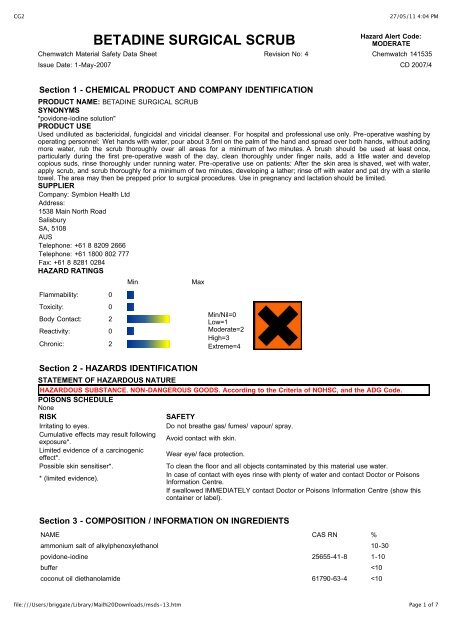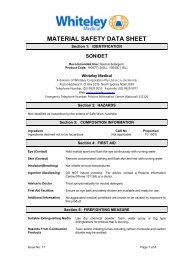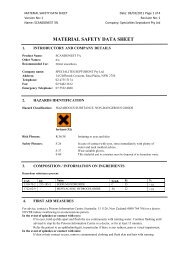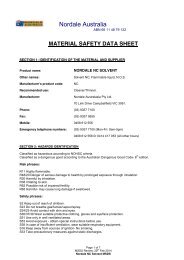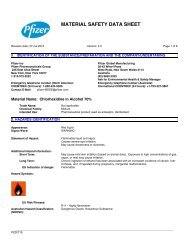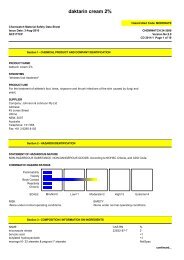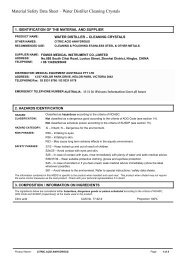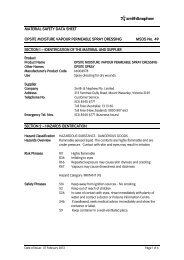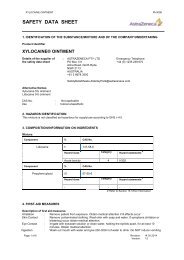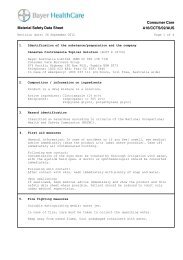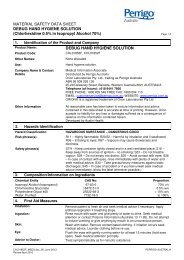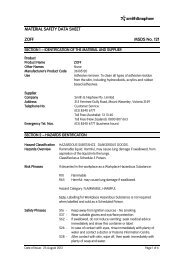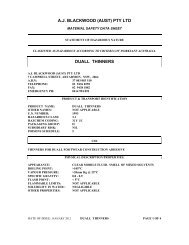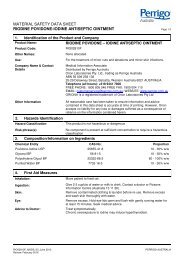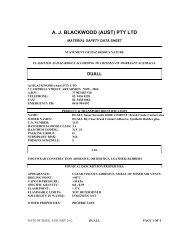BETADINE SURGICAL SCRUB - Briggate Medical Company
BETADINE SURGICAL SCRUB - Briggate Medical Company
BETADINE SURGICAL SCRUB - Briggate Medical Company
You also want an ePaper? Increase the reach of your titles
YUMPU automatically turns print PDFs into web optimized ePapers that Google loves.
CG2<br />
27/05/11 4:04 PM<br />
<strong>BETADINE</strong> <strong>SURGICAL</strong> <strong>SCRUB</strong><br />
Hazard Alert Code:<br />
MODERATE<br />
Chemwatch Material Safety Data Sheet Revision No: 4 Chemwatch 141535<br />
Issue Date: 1-May-2007 CD 2007/4<br />
Section 1 - CHEMICAL PRODUCT AND COMPANY IDENTIFICATION<br />
PRODUCT NAME: <strong>BETADINE</strong> <strong>SURGICAL</strong> <strong>SCRUB</strong><br />
SYNONYMS<br />
"povidone-iodine solution"<br />
PRODUCT USE<br />
Used undiluted as bactericidal, fungicidal and viricidal cleanser. For hospital and professional use only. Pre-operative washing by<br />
operating personnel: Wet hands with water, pour about 3.5ml on the palm of the hand and spread over both hands, without adding<br />
more water, rub the scrub thoroughly over all areas for a minimum of two minutes. A brush should be used at least once,<br />
particularly during the first pre-operative wash of the day, clean thoroughly under finger nails, add a little water and develop<br />
copious suds, rinse thoroughly under running water. Pre-operative use on patients: After the skin area is shaved, wet with water,<br />
apply scrub, and scrub thoroughly for a minimum of two minutes, developing a lather; rinse off with water and pat dry with a sterile<br />
towel. The area may then be prepped prior to surgical procedures. Use in pregnancy and lactation should be limited.<br />
SUPPLIER<br />
<strong>Company</strong>: Symbion Health Ltd<br />
Address:<br />
1538 Main North Road<br />
Salisbury<br />
SA, 5108<br />
AUS<br />
Telephone: +61 8 8209 2666<br />
Telephone: +61 1800 802 777<br />
Fax: +61 8 8281 0284<br />
HAZARD RATINGS<br />
Flammability: 0<br />
Toxicity: 0<br />
Body Contact: 2<br />
Reactivity: 0<br />
Chronic: 2<br />
Min<br />
Section 2 - HAZARDS IDENTIFICATION<br />
Max<br />
Min/Nil=0<br />
Low=1<br />
Moderate=2<br />
High=3<br />
Extreme=4<br />
STATEMENT OF HAZARDOUS NATURE<br />
HAZARDOUS SUBSTANCE. NON-DANGEROUS GOODS. According to the Criteria of NOHSC, and the ADG Code.<br />
POISONS SCHEDULE<br />
None<br />
RISK<br />
SAFETY<br />
Irritating to eyes.<br />
Do not breathe gas/ fumes/ vapour/ spray.<br />
Cumulative effects may result following<br />
Avoid contact with skin.<br />
exposure*.<br />
Limited evidence of a carcinogenic<br />
Wear eye/ face protection.<br />
effect*.<br />
Possible skin sensitiser*.<br />
To clean the floor and all objects contaminated by this material use water.<br />
In case of contact with eyes rinse with plenty of water and contact Doctor or Poisons<br />
* (limited evidence).<br />
Information Centre.<br />
If swallowed IMMEDIATELY contact Doctor or Poisons Information Centre (show this<br />
container or label).<br />
Section 3 - COMPOSITION / INFORMATION ON INGREDIENTS<br />
NAME CAS RN %<br />
ammonium salt of alkylphenoxylethanol 10-30<br />
povidone-iodine 25655-41-8 1-10<br />
buffer
CG2<br />
27/05/11 4:04 PM<br />
water 7732-18-5 >60<br />
NOTE: Manufacturer has supplied full ingredient<br />
information to allow CHEMWATCH assessment.<br />
Section 4 - FIRST AID MEASURES<br />
SWALLOWED<br />
If swallowed do NOT induce vomiting.<br />
If vomiting occurs, lean patient forward or place on left side (head-down position, if possible) to maintain open airway and<br />
prevent aspiration.<br />
Observe the patient carefully.<br />
Never give liquid to a person showing signs of being sleepy or with reduced awareness; i.e. becoming unconscious.<br />
Give water to rinse out mouth, then provide liquid slowly and as much as casualty can comfortably drink.<br />
Seek medical advice.<br />
EYE<br />
If this product comes in contact with the eyes:<br />
Wash out immediately with fresh running water.<br />
Ensure complete irrigation of the eye by keeping eyelids apart and away from eye and moving the eyelids by occasionally lifting<br />
the upper and lower lids.<br />
If pain persists or recurs seek medical attention.<br />
Removal of contact lenses after an eye injury should only be undertaken by skilled personnel.<br />
SKIN<br />
If skin or hair contact occurs:<br />
Flush skin and hair with running water (and soap if available).<br />
Seek medical attention in event of irritation.<br />
INHALED<br />
If fumes or combustion products are inhaled remove from contaminated area.<br />
Lay patient down. Keep warm and rested.<br />
Prostheses such as false teeth, which may block airway, should be removed, where possible, prior to initiating first aid<br />
procedures.<br />
Apply artificial respiration if not breathing, preferably with a demand valve resuscitator, bag-valve mask device, or pocket mask<br />
as trained. Perform CPR if necessary.<br />
Transport to hospital, or doctor.<br />
NOTES TO PHYSICIAN<br />
Treat symptomatically.<br />
Section 5 - FIRE FIGHTING MEASURES<br />
EXTINGUISHING MEDIA<br />
There is no restriction on the type of extinguisher which may be used.<br />
FIRE FIGHTING<br />
Alert Fire Brigade and tell them location and nature of hazard.<br />
Wear breathing apparatus plus protective gloves for fire only.<br />
Prevent, by any means available, spillage from entering drains or water courses.<br />
Use fire fighting procedures suitable for surrounding area.<br />
DO NOT approach containers suspected to be hot.<br />
Cool fire exposed containers with water spray from a protected location.<br />
If safe to do so, remove containers from path of fire.<br />
Equipment should be thoroughly decontaminated after use.<br />
FIRE/EXPLOSION HAZARD<br />
Non combustible.<br />
Not considered to be a significant fire risk.<br />
Expansion or decomposition on heating may lead to violent rupture of containers.<br />
Decomposes on heating and may produce toxic fumes of carbon monoxide (CO).<br />
May emit acrid smoke.<br />
FIRE INCOMPATIBILITY<br />
None known.<br />
HAZCHEM<br />
None<br />
Section 6 - ACCIDENTAL RELEASE MEASURES<br />
EMERGENCY PROCEDURES<br />
MINOR SPILLS<br />
Slippery when spilt.<br />
Clean up all spills immediately.<br />
Avoid breathing vapours and contact with skin and eyes.<br />
Control personal contact by using protective equipment.<br />
file:///Users/briggate/Library/Mail%20Downloads/msds-13.htm<br />
Page 2 of 7
CG2<br />
27/05/11 4:04 PM<br />
Contain and absorb spill with sand, earth, inert material or vermiculite.<br />
Wipe up.<br />
Place in a suitable labelled container for waste disposal.<br />
MAJOR SPILLS<br />
Slippery when spilt.<br />
Minor hazard.<br />
Clear area of personnel.<br />
Alert Fire Brigade and tell them location and nature of hazard.<br />
Control personal contact by using protective equipment as required.<br />
Prevent spillage from entering drains or water ways.<br />
Contain spill with sand, earth or vermiculite.<br />
Collect recoverable product into labelled containers for recycling.<br />
Absorb remaining product with sand, earth or vermiculite and place in appropriate containers for disposal.<br />
Wash area and prevent runoff into drains or waterways.<br />
If contamination of drains or waterways occurs, advise emergency services.<br />
SAFE STORAGE WITH OTHER CLASSIFIED CHEMICALS<br />
+ X + X 0 +<br />
X: Must not be stored together<br />
O: May be stored together with specific preventions<br />
+: May be stored together<br />
Personal Protective Equipment advice is contained in Section 8 of the MSDS.<br />
Section 7 - HANDLING AND STORAGE<br />
PROCEDURE FOR HANDLING<br />
Limit all unnecessary personal contact.<br />
Wear protective clothing when risk of exposure occurs.<br />
Use in a well-ventilated area.<br />
Avoid contact with incompatible materials.<br />
When handling, DO NOT eat, drink or smoke.<br />
Keep containers securely sealed when not in use.<br />
Avoid physical damage to containers.<br />
Always wash hands with soap and water after handling.<br />
Work clothes should be laundered separately.<br />
Use good occupational work practice.<br />
Observe manufacturer's storing and handling recommendations.<br />
Atmosphere should be regularly checked against established exposure standards to ensure safe working conditions are<br />
maintained.<br />
SUITABLE CONTAINER<br />
Polyethylene or polypropylene container.<br />
Check all containers are clearly labelled and free from leaks.<br />
STORAGE INCOMPATIBILITY<br />
None known.<br />
STORAGE REQUIREMENTS<br />
Store in original containers.<br />
Keep containers securely sealed.<br />
Store in a cool, dry, well-ventilated area.<br />
Store away from incompatible materials and foodstuff containers.<br />
Protect containers against physical damage and check regularly for leaks.<br />
Observe manufacturer's storing and handling recommendations.<br />
Section 8 - EXPOSURE CONTROLS / PERSONAL PROTECTION<br />
EXPOSURE CONTROLS<br />
Source<br />
Material<br />
Australia Exposure povidone-iodine (Inspirable dust (not<br />
Standards<br />
otherwise classified))<br />
The following materials had no OELs on our records<br />
• coconut oil diethanolamide: CAS:61790-63-4<br />
• water:<br />
CAS:7732-18-5<br />
TWA<br />
ppm<br />
TWA<br />
mg/m³<br />
10<br />
STEL<br />
ppm<br />
STEL<br />
mg/m³<br />
Peak<br />
ppm<br />
Peak<br />
mg/m³<br />
TWA<br />
F/CC<br />
file:///Users/briggate/Library/Mail%20Downloads/msds-13.htm<br />
Page 3 of 7
CG2<br />
27/05/11 4:04 PM<br />
ODOUR SAFETY FACTOR (OSF)<br />
OSF=1.7 (coconut oil diethanolamide)<br />
Exposed individuals are NOT reasonably expected to be warned, by smell, that the Exposure Standard is being exceeded.<br />
Odour Safety Factor (OSF) is determined to fall into either Class C, D or E.<br />
The Odour Safety Factor (OSF) is defined as:<br />
OSF= Exposure Standard (TWA) ppm/ Odour Threshold Value (OTV) ppm<br />
Classification into classes follows:<br />
Class OSF Description<br />
A 550<br />
Over 90% of exposed individuals are<br />
aware by smell that the Exposure<br />
Standard (TLV-TWA for example) is being<br />
reached, even when distracted by working<br />
activities<br />
B 26-550<br />
As "A" for 50-90% of persons being<br />
distracted<br />
C 1-26<br />
As "A" for less than 50% of persons being<br />
distracted<br />
D 0.18-1<br />
10-50% of persons aware of being tested<br />
perceive by smell that the Exposure<br />
Standard is being reached<br />
E
CG2<br />
27/05/11 4:04 PM<br />
5000 50 Airline * -<br />
5000 100 - AK-2 P<br />
10000 100 - AK-3 P<br />
100+ Airline**<br />
* - Continuous Flow ** - Continuous-flow or positive pressure demand.<br />
The local concentration of material, quantity and conditions of use determine the type of personal protective equipment required.<br />
For further information consult site specific CHEMWATCH data (if available), or your Occupational Health and Safety Advisor.<br />
ENGINEERING CONTROLS<br />
General exhaust is adequate under normal operating conditions. If risk of overexposure exists, wear SAA approved respirator.<br />
Correct fit is essential to obtain adequate protection. Provide adequate ventilation in warehouse or closed storage areas. Air<br />
contaminants generated in the workplace possess varying "escape" velocities which, in turn, determine the "capture velocities" of<br />
fresh circulating air required to effectively remove the contaminant.<br />
Type of Contaminant:<br />
Air Speed:<br />
solvent, vapours, degreasing etc., evaporating from tank (in still<br />
air)<br />
0.25-0.5 m/s (50-100 f/min)<br />
aerosols, fumes from pouring operations, intermittent container<br />
filling, low speed conveyer transfers, welding, spray drift, plating<br />
acid fumes, pickling (released at low velocity into zone of active<br />
0.5-1 m/s (100-200 f/min.)<br />
generation)<br />
direct spray, spray painting in shallow booths, drum filling,<br />
conveyer loading, crusher dusts, gas discharge (active 1-2.5 m/s (200-500 f/min)<br />
generation into zone of rapid air motion)<br />
grinding, abrasive blasting, tumbling, high speed wheel<br />
generated dusts (released at high initial velocity into zone of 2.5-10 m/s (500-2000 f/min.)<br />
very high rapid air motion).<br />
Within each range the appropriate value depends on:<br />
Lower end of the range<br />
Upper end of the range<br />
1: Room air currents minimal or favourable to capture 1: Disturbing room air currents<br />
2: Contaminants of low toxicity or of nuisance value only 2: Contaminants of high toxicity<br />
3: Intermittent, low production. 3: High production, heavy use<br />
4: Large hood or large air mass in motion 4: Small hood - local control only<br />
Simple theory shows that air velocity falls rapidly with distance away from the opening of a simple extraction pipe. Velocity<br />
generally decreases with the square of distance from the extraction point (in simple cases). Therefore the air speed at the<br />
extraction point should be adjusted, accordingly, after reference to distance from the contaminating source. The air velocity at the<br />
extraction fan, for example, should be a minimum of 1-2 m/s (200-400 f/min.) for extraction of solvents generated in a tank 2<br />
meters distant from the extraction point. Other mechanical considerations, producing performance deficits within the extraction<br />
apparatus, make it essential that theoretical air velocities are multiplied by factors of 10 or more when extraction systems are<br />
installed or used.<br />
Section 9 - PHYSICAL AND CHEMICAL PROPERTIES<br />
APPEARANCE<br />
Dark brown viscous liquid without cloudiness or sedimentation. Slight odour of iodine. Mixes with water.<br />
PHYSICAL PROPERTIES<br />
Liquid.<br />
Mixes with water.<br />
Molecular Weight: Not applicable<br />
Boiling Range (°C): Not available<br />
Melting Range (°C): Not available Specific Gravity (water=1): 1.031-1.041<br />
Solubility in water (g/L): Miscible pH (as supplied): 4.0-5.6<br />
pH (1% solution): Not available<br />
Vapour Pressure (kPa): Not available<br />
Volatile Component (%vol): Not available<br />
Evaporation Rate: Not available<br />
Relative Vapour Density (air=1): Not available<br />
Flash Point (°C): Not applicable<br />
Lower Explosive Limit (%): Not applicable<br />
Upper Explosive Limit (%): Not applicable<br />
Autoignition Temp (°C): Not applicable<br />
Decomposition Temp (°C): Not available<br />
State: Liquid<br />
Viscosity: Not available<br />
Section 10 - CHEMICAL STABILITY AND REACTIVITY INFORMATION<br />
CONDITIONS CONTRIBUTING TO INSTABILITY<br />
Product is considered stable and hazardous polymerisation will not occur.<br />
Section 11 - TOXICOLOGICAL INFORMATION<br />
POTENTIAL HEALTH EFFECTS<br />
ACUTE HEALTH EFFECTS<br />
SWALLOWED<br />
Considered an unlikely route of entry in commercial/industrial environments.<br />
file:///Users/briggate/Library/Mail%20Downloads/msds-13.htm<br />
Page 5 of 7
CG2<br />
27/05/11 4:04 PM<br />
The liquid is. discomforting to the gastro-intestinal tract.<br />
Ingestion may result in nausea, abdominal irritation, pain and vomiting if swallowed in large quantity.<br />
EYE<br />
The liquid may produce eye discomfort causing smarting, pain and redness.<br />
SKIN<br />
The liquid may be. slightly discomforting to the skin if exposure is prolonged and is capable of causing transient staining of the skin<br />
and skin reactions which may lead to dermatitis from repeated exposures over long periods.<br />
Not considered an irritant through normal use.<br />
INHALED<br />
Not normally a hazard due to non-volatile nature of product.<br />
CHRONIC HEALTH EFFECTS<br />
Primary route of exposure is usually by skin contact.<br />
Iodine and iodides cause goitre and diminished as well as increased activity of the thyroid gland. A toxic syndrome resulting from<br />
chronic iodide overdose and from repeated administration of small amounts of iodine is characterised by excessive saliva<br />
production, head cold, sneezing, conjunctivitis, headache, fever, laryngitis, inflammation of the bronchi and mouth cavity, inflamed<br />
parotid gland, and various skin rashes. Swelling and inflammation of the throat, irritated and swollen eyes and lung swelling may<br />
also occur. Swelling of the glottis, necessitating a tracheotomy has been reported. Use of iodides in pregnancy can cause foetal<br />
death, severe goitre, hypothyroidism and the cretinoid appearance of the newborn.<br />
TOXICITY AND IRRITATION<br />
Not available. Refer to individual constituents.<br />
POVIDONE-IODINE:<br />
unless otherwise specified data extracted from RTECS - Register of Toxic Effects of Chemical Substances.<br />
TOXICITY<br />
IRRITATION<br />
Oral (rat) LD50: >8000 mg/k<br />
Skin (rabbit): 500 mg Mild<br />
Oral (rat) LD50: 5990 mg/kg * [* = Manufacturer]<br />
Dermal (human) TDLo: 3400 mg/Kg/24h<br />
The material may cause skin irritation after prolonged or repeated exposure and may produce on contact skin redness, swelling,<br />
the production of vesicles, scaling and thickening of the skin.<br />
COCONUT OIL DIETHANOLAMIDE:<br />
None assigned. Refer to individual constituents.<br />
WATER:<br />
unless otherwise specified data extracted from RTECS - Register of Toxic Effects of Chemical Substances.<br />
No significant acute toxicological data identified in literature search.<br />
Section 12 - ECOLOGICAL INFORMATION<br />
No data for Betadine Surgical Scrub.<br />
Refer to data for ingredients, which follows:<br />
POVIDONE-IODINE:<br />
Iodine is an important element in studies of environmental protection and human health, global-scale hydrologic processes and<br />
nuclear nonproliferation. Biogeochemical cycling of iodine is complex, because iodine occurs in multiple oxidation states and as<br />
inorganic and organic species that may be hydrophilic, atmophilic, and biophilic. Experiments illustrate complex behavior with<br />
various processes occurring, including iodate reduction, irreversible retention or mass loss of iodide, and rate-limited and nonlinear<br />
sorption. There was an appreciable iodate reduction to iodide, presumably mediated by the structural Fe(II) in some clay minerals;<br />
therefore, careful attention must be given to potential interconversion among species when interpreting the biogeochemical<br />
behavior of iodine in the environment.<br />
Iodine (I2) is electrochemically reduced to ionic iodide by natural processes but humic acid appears to promote the reaction. The<br />
different oxidation species of iodine have markedly different sorption properties. Hence, changes in iodine redox states can greatly<br />
affect the mobility of iodine in the environment. A major microbial role has been suggested in the past to account for at least some<br />
of these redox changes. Both soluble ferrous iron and sulfide, as well as iron monosulfide (FeS) were shown to abiologically reduce<br />
iodate to iodide. These results indicate that ferric iron and/or sulfate reducing bacteria are capable of mediating both direct,<br />
enzymatic, as well as abiotic reduction of iodate in natural anaerobic environments.<br />
Environmental and geological evidence indicates that iodine can become associatedwith natural organic matter (NOM) in soils and<br />
sediments. Previous studies have shown that iodine (including 129II) can be strongly retained in organic-rich surface soils and<br />
sediment and that soluble iodine may be associated with dissolved humic material. Iodine and iodate undergo an abiotic pseudo<br />
first-order reaction with peat leading to either reduction of iodate or iodine to iodide or incorporation of the iodine atoms into the<br />
organic matrix. Iodine appears to be incorporated in sphagnum peat by aromatic substitution for hydrogen on phenolic constituents<br />
of the peat.<br />
DO NOT discharge into sewer or waterways.<br />
Section 13 - DISPOSAL CONSIDERATIONS<br />
Recycle wherever possible or consult manufacturer for recycling options.<br />
Consult State Land Waste Management Authority for disposal.<br />
Bury residue in an authorised landfill.<br />
Recycle containers if possible, or dispose of in an authorised landfill.<br />
Section 14 - TRANSPORTATION INFORMATION<br />
HAZCHEM: None<br />
NOT REGULATED FOR TRANSPORT OF DANGEROUS GOODS:UN, IATA,<br />
IMDG<br />
file:///Users/briggate/Library/Mail%20Downloads/msds-13.htm<br />
Page 6 of 7
CG2<br />
27/05/11 4:04 PM<br />
Section 15 - REGULATORY INFORMATION<br />
POISONS SCHEDULE<br />
None<br />
REGULATIONS<br />
Betadine Surgical Scrub (CAS: None):<br />
No regulations applicable<br />
povidone- iodine (CAS: 25655- 41- 8) is found on the following regulatory lists;<br />
Australia Exposure Standards<br />
Australia Illicit Drug Precursors/Reagents - Category II<br />
Australia Inventory of Chemical Substances (AICS)<br />
coconut oil diethanolamide (CAS: 61790- 63- 4) is found on the following<br />
regulatory lists;<br />
Australia High Volume Industrial Chemical List (HVICL)<br />
Australia Inventory of Chemical Substances (AICS)<br />
OECD Representative List of High Production Volume (HPV) Chemicals<br />
water (CAS: 7732- 18- 5) is found on the following regulatory lists;<br />
Australia Inventory of Chemical Substances (AICS)<br />
IMO IBC Code Chapter 18: List of products to which the Code does not apply<br />
OECD Representative List of High Production Volume (HPV) Chemicals<br />
United Nations Convention Against Illicit Traffic in Narcotic Drugs and<br />
Psychotropic Substances - Table II<br />
Section 16 - OTHER INFORMATION<br />
Classification of the preparation and its individual components has drawn on official and authoritative sources as well as<br />
independent review by the Chemwatch Classification committee using available literature references.<br />
A list of reference resources used to assist the committee may be found at:<br />
www.chemwatch.net/references.<br />
The (M)SDS is a Hazard Communication tool and should be used to assist in the Risk Assessment. Many factors determine<br />
whether the reported Hazards are Risks in the workplace or other settings. Risks may be determined by reference to Exposures<br />
Scenarios. Scale of use, frequency of use and current or available engineering controls must be considered.<br />
This document is copyright. Apart from any fair dealing for the purposes of private study, research, review or criticism, as permitted<br />
under the Copyright Act, no part may be reproduced by any process without written permission from CHEMWATCH. TEL (+61 3)<br />
9572 4700.<br />
Issue Date: 1-May-2007<br />
Print Date: 12-Mar-2008<br />
file:///Users/briggate/Library/Mail%20Downloads/msds-13.htm<br />
Page 7 of 7


